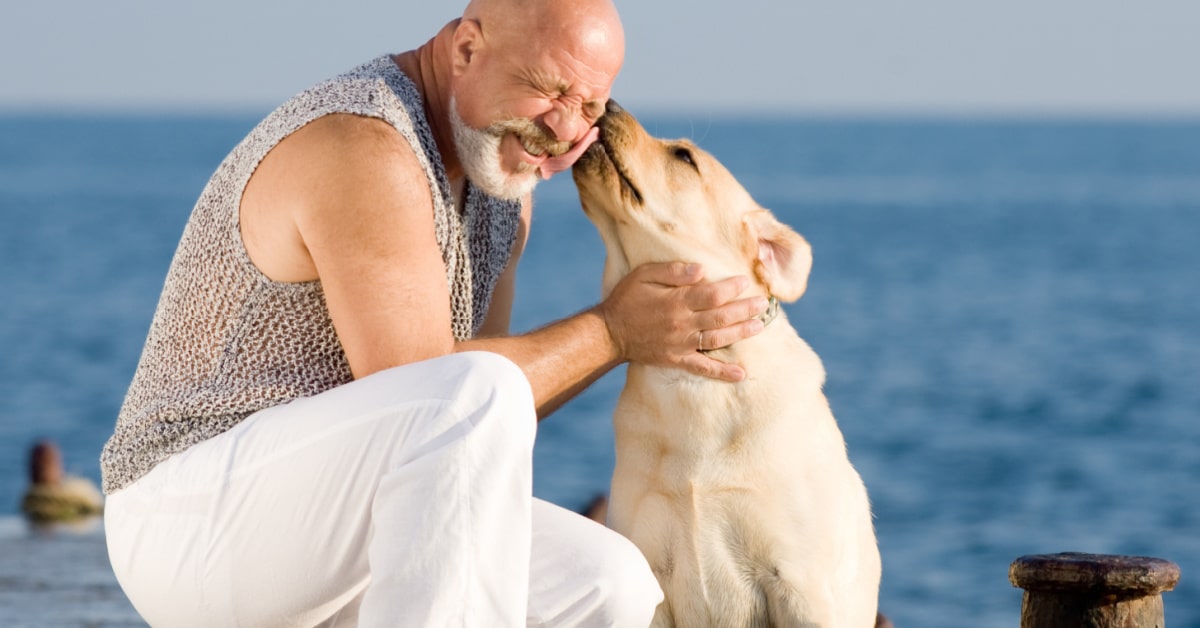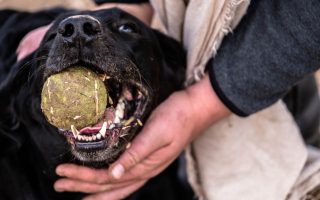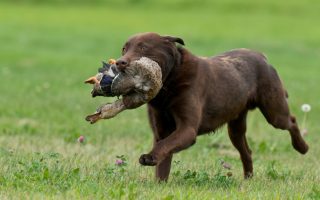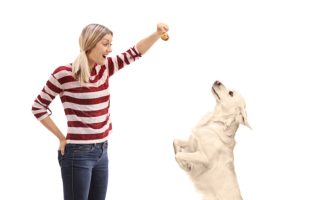Teaching your dog to ‘kiss’ is one of the favoured tricks that you can show off to your friends and family. And fortunately, it is quite simple to know how to teach your Lab to kiss.
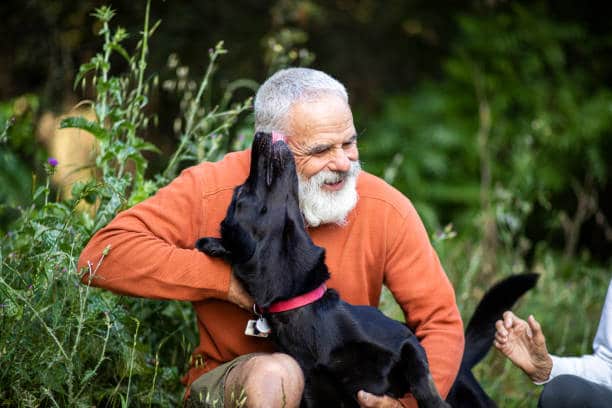
For this article, we will be going over several methods that you can use to teach your lab how to kiss.
Although the kiss trick can be quite messy, it can still be a lot of fun and provides plenty of engagement for you and your dog.
Capturing the kiss
Teaching methods vary depending on the owners. Some methods will be more effective for some people while some methods may seem less so. You can easily teach your lab to kiss with this guide.
Capturing a trick or movement to replicate it in the future is one of the tried and tested methods that work well for training your dog.
It’s best for tricks that your dog already does on their own without any prompting, though it could still work for other actions as well.
1) Wait until your dog kisses you
The first thing to do with capturing a kiss is simply wait for it. You can also try to lure your dog into situations where they will be more affectionate and thus likely to kiss you or lick you.
2) Capture the moment
The crucial part of this method is to capture the moment. There are two ways that you can do this, both with equipment and without it.
When your dog proceeds to kiss you, you can say a command phrase such as ‘kisses’ or ‘give kisses’.
Alternatively, you can also use a clicker to capture the action. Whenever they kiss you, you should click on the clicker to signify that this is an action you want them to do.
You can get creative with the phrase that you use as long as you can keep it simple and it won’t be something that your dog will confuse for another command.
3) Repeat
Continue with repeating the first two steps. It should also be noted that you can also mark their behaviour whenever they do it on other people.
The training is not only limited to you and you should take the times that they kiss other members of the family as an opportunity.
If you live alone, there won’t be chances for this, but it’s perfectly okay otherwise.
The most important part is repeating the marking so that they know that a kiss is something you want to take note of.
Remember, your dog’s brain does not work in the same way that yours does.
They will need a lot of repetition and reinforcement to understand that you want them to do a specific thing.
Repeating it over the course of a couple of days will be very helpful in making the process much faster.
Of course, you should also be consistent in your capture of their behavior. Anytime they kiss you, you can use the clicker or just say a verbal cue indicating a kiss.
This way, you are maximizing every possible opportunity for practice, even if it just when you are spending regular bonding time with your dog.
4) Treats, treats, treats!
Next, don’t forget all the treats and praise. A very important part of teaching your dog something is giving them an incentive to the training.
In many cases, this will come in the form of your Lab’s favourite treats.
When they successfully perform a kiss and you have properly marked it, make sure to give them a treat and lots of praise for doing it successfully.
This will keep the training engaging and fun since both of you are getting something from it.
Over time, you will have to lessen the number of treats as your dog will have learned the trick after some time. Still, make sure to insert treats here and there whenever they do the kiss correctly. So giving treats on completing the task also teach our lab to kiss.
Luring them in to kiss you
Another approach would be to convince them to kiss you by luring them in with treats. This method is preferable if kissing is an action that your dog doesn’t do a lot.
1) The ‘lure’
The first step of this method is to actually convince them to kiss you in the first place. That won’t be a problem with a little bit of coaxing through a yummy treat.
Note that this might get a little messy, so if you’re one to balk at some licking or using some food, then you might want to have a friend or family member volunteer for the task.
You can start by placing a dollop of peanut butter on your cheek. Understandably, this might not be for everyone.
You can also substitute this by placing a treat on your cheek and waiting for your dog to come to get the treat or lick the food off of your cheek.
As you can see, it involves a lot of getting close together with your dog and using food that could get all over the place.
Make sure to have cleaning materials ready just in case some of the food gets on the floor or furniture.
In line with that, you should also do this in an area that’s easy to clean, preferably with hard floors that you won’t have trouble wiping down.
2) The cue
Once they’ve started to lick the treat off of your cheek, say your chosen command phrase such as ‘kiss’. This is only an example and you can choose whatever you like and whatever you find most appropriate.
Keep the cue short and simple so as to not confuse your dog. The best cues are the ones that your dog can easily set apart from other commands so that there will be no confusion.
Be sure to say the cue when your dog is already doing the action because this will signify that what they are doing right now is what the cue means, not the moment before or the one after that.
3) Praise
Of course, the food that they’ll be licking from your face is already enough! With their love for food, you won’t have trouble getting them to lick the food from your cheek.
But you still need to encourage them verbally and praise them through your words. Your praise still means a lot and is just as important as the edible treat.
There are even studies that can back this up. The results of this study indicate that a social reward for good behavior is preferable to food rewards in some dogs.
This just shows that your positivity and praise for them goes a long way in making the training sessions enjoyable.
4) Repetition
Try this out a couple of times each day. Remember to keep the practice sessions as short as possible, so you won’t lose your Lab’s attention.
Repetition is key to developing any trick. You shouldn’t expect that your dog will get it after just one training session.
Even the most trainable breeds will still take time and effort.
With that, it is also important that you stay patient throughout the process and try your best to give positive reactions.
It can get frustrating if your dog doesn’t understand what you are trying to say, but you must be accepting of the limitations.
Using sticky notes
If you prefer a less physical approach to the kiss command, you can try out the sticky notes method.
It’s best for people who want to train their dog to kiss on cue but don’t actually want to spend multiple times a day for a few weeks being kissed by their dog.
1) The sticky note
The key item here is the sticky note as it will act as a target. You can begin by placing the sticky part of the note on the tip of your index finger and holding it out in front of you.
Placing it right in front of them will make the note a very visible object.
Next, you should coax them to touch their nose to the piece of paper. At first, this will be challenging as your dog will not immediately know that you want them to kiss the note.
But given enough prodding, your dog will eventually get it.
2) The cue
Don’t forget to mention the cue word or phrase as your dog is doing the action. This is what you will use later on further in the training.
The cue is even more important in this method as you are not luring them in with treats.
Thus, it is incredibly important that you get your point across through an effective cue word or phrase.
Make sure to be assertive when saying the cue, but avoid being forceful.
3) Moving the target
Once your dog has gotten used to the idea of kissing and they now recognize the cur word for what it is, you can start moving around the sticky note.
This provides your dog tons of opportunities to practice the motion without actually doing it on your cheek.
Plus, you don’t have to actually sit down with them while you are teaching them.
Even instructing from a distance will suffice so long as they see the target visibly.
4) Treats and praise
Remember, the first few parts of the motion don’t actually involve treats, which is what makes this method quite different from the others.
Instead of luring them in with a treat, you will only be rewarding them after they have performed the action.
Thus, you need to really go all out with the praise and the treats when they get it right.
As per usual, don’t forget to repeat the above steps a couple of times. This will allow your dog to familiarize the target and the cue phrase.
5) Stick the note to your cheek
Once you are already confident in your dog’s ability to follow the cue, you can start putting the target on your cheek and then making the command. They will then, of course, kiss your cheek.
If they don’t do so, you may have to revisit the previous steps. But if they do, then that’s a good thing!
Just repeat this step a couple more times and don’t forget to add tons of treats and praise in the process.
Remove the target
The last step is to remove the target and just gesture to your cheek. When you say the command, they should go ahead and kiss your cheek.
In real-life scenarios, teach your lab something that will not be this streamlined to kiss.
You will have to go back to some steps more than once.
However, you should know that it’s perfectly fine to retrace a little bit. They will eventually understand given enough practice. As Teach your Lab to kiss is an important step in any relationship.

